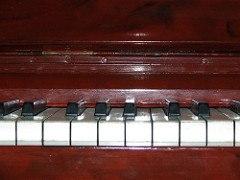Piano Accompaniment
Many musicians play alongside a bassist in the same way they play when performing solo, but in theory, this is incorrect. While you can do it occasionally, you should “pick your spots” wisely. Personally, I am not fond of this type of playing because when your left hand plays a C two octaves below middle C on the keyboard while the bassist also plays a C note, it creates a muddy sound, which is undesirable.
Instead of playing the same notes as the bassist, here are some alternatives you can try:
- Play something different from what the bassist is playing. The options are endless, and I will explain below.
- Let your left hand play chord notes around middle C. Regardless of the key, trust your ear to determine if the sound becomes too muddy.
In the key of C, you can use major 7th, minor 7th, dominant 7th, and diminished 7th chords.
It is important to learn how to play these types of chords with your left hand in various inversions. As you play, you will discover which inversions work best for you.
Now, this is not rocket science. Here’s an example:
Let’s use the … ...Read the rest.
“Piano Accompaniment”


 Manuel is a passionate, driven, and techsavvy AV technician,
Manuel is a passionate, driven, and techsavvy AV technician, 

Recent Comments